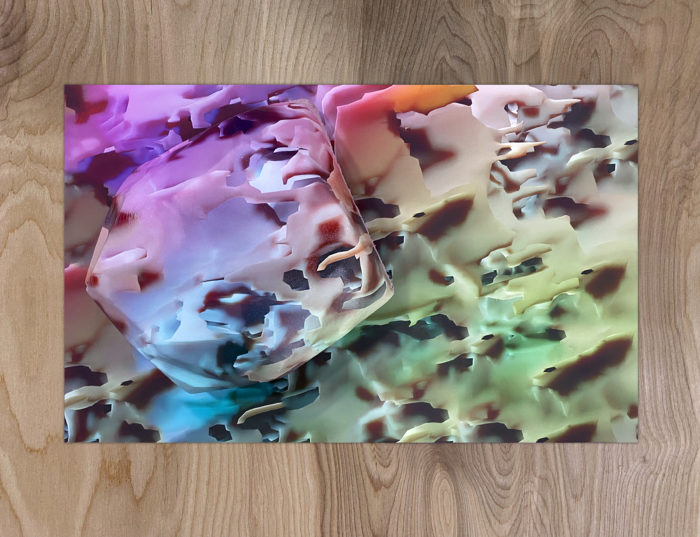New Art Writing by Sandy Bonny, on the work of Jason Urban & Leslie Mutchler
Essay available in LARGE FONT
Reflecting on Speculative Geologies, hybrid arts, and the geologic imagination
by Sandy Bonny
Alongside plate tectonics, deep time, and geologic landforms, my first-year geology class introduces students to the physical properties of rocks and minerals. Sometimes our teaching samples disappear… especially if they are small, sparkly, or magnetic. It seems that humans, perhaps especially those destined to become geologists and artists, have a strong drive to pocket stones. In their ethically murky relocation to students’ bookshelves and bedside tables, I like to think that these wandering artefacts honour their teaching roles. Collectors begin their practice, after all, by learning what is common, what is rare, and what is worthy of attention.
During Covid 19, I taught remotely with a virtual gallery of annotated rock and mineral samples that Brooklyn-based artists, Jason Urban and Leslie Mutchler’s (JULM)(1), Speculative Geologies mirrors curiously.
Printmakers by training, JULM describe their art as circling the practice and politics of reproduction. They engage the media of light, pigment, found materials, and, most recently, the digital diode. Covid 19 played an important role in Speculative Geologies, which developed parallel to a website they conceived for pandemic teaching(2), and in partial response to a locked-down gallery installation they created, which no audience could tour. With Speculative Geologies, JULM claim space in a hybrid world of virtual and experiential creativity and offer us imaginary rocks, gathered and indexed by desire.
Speculative Geologies incorporates large-scale prints and projections of geofacts; objects reverse-engineered from utopian utilities, with geologically-inspired properties that emerged in silent collaboration between artistic intent and intelligent software algorithms. Each speculative geofact (geofiction?) is linked by poetic text to a social function that we do, or may soon, expect of our digital devices. One sample makes false promises, another provides helpful gaming shortcuts; each, introduced daily over the past year to JULM’s Instagram feed, affirms the increasing entanglement of our social and psychological realities with elementally animated technologies.
Within Eastern Edge gallery spaces, these digitally birthed stones will also appear as physical objects. Speculative “rocks”, created by heat wrapping UV printed vinyl to sculpted polystyrene forms, renegotiate the boundaries of the virtual and manifest, and gesture to geologic provenance. In JULM’s practice, the conceptual distinction of rocks, and bones, and living beings is exposed as an artefact of human cognition. Polystyrene is a refined product of hydrocarbon; not “artificial” really, only polymerized and refracted through the lens of human utilitarianism.
Pragmatically, polystyrene foam is also abundant in Brooklyn and much more easily gathered and repurposed for art than stone. (In fact, a sample of magnesite(3) that anchored JULM’s 2014/15 installation, UNIVERSAL(4), had to be ordered in from Nevada on eBay.) One of my favourite undergraduate geology classes involved drawing detailed sketches of gravel, as an exercise in yielding our attention to overlooked geological detritus and the stories it can tell. As an interdisciplinary “teaching collection”, Speculative Geologies’ visually detailed and poetically nuanced exploration of both human expectations and utopian materials nudges its audience toward new narratives about the mineral world.
Historian Will Durant famously wrote that “Civilization exists by geological consent, subject to change without notice.”(5) He was referring to geologic hazards; earthquakes, volcanoes and climate events that disrupt our lives in sudden and irrevocable ways. Speculative Geologies calls focus to the rapid planetary metamorphoses that science, art, and the geologic imagination have set underway—largely without intention—in the digital Anthropocene. I suggest that you let yourself be carried away by JULM’s kaleidoscopic speculations. Take the gallery brochure home, put it on your kitchen table, and let it whisper beautiful and useful questions.
Note: This essay was written after a great conversation between Jason Urban, Leslie Mutchler, and I, hosted between two locations in Brooklyn, NY, and one in Saskatoon, SK, via Zoom, in collaboration with the aluminum, antimony, arsenic, barium, beryllium, cadmium, carbon, chromium, cobalt, copper, europium, gallium, gold, iron, lead, neodymium, manganese, mercury, palladium, platinum, quartz, selenium, silver, terbium, yttrium and zinc (and background cast) in our devices, and with thanks to cooperating satellites.
______________
1 https://julmstudios.com/
2 https://colorimpracticum.space/
3 Magnesite (MgCO3) is refined to produce printer’s ink and stiffening compounds.
4 https://julmstudios.com/UNIVERSAL
5 Durant W. (1946). What is civilization. Ladies’ Home Journal, 63, 22-23.
Sandy Marie Bonny is a writer, artist, and Earth scientist (PhD 2007) enjoying life in Saskatoon, SK / Treaty 6 territory and the homeland of the Métis. Her visual art practice includes deep-relief carving, dimensional sculpture, and narrative landscapes. Her writing has appeared in academic and literary journals and collections, including Oberon Press’ 2011 anthology Coming Attractions; and JK Peter’s The Shape of Content: Creative Writing in Mathematics and Science. She is the author of two books, The Sometimes Lake (stories, 2012) and Yes, and Back Again (novel, 2015) published with Thistledown Press. By day, Sandy brings science, stories, and students together as an instructor and program lead in the College of Arts and Science at the University of Saskatchewan.

